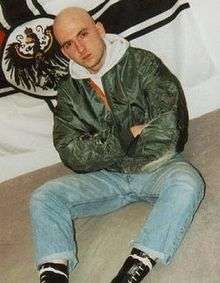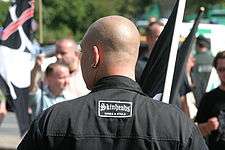White power skinhead

White power skinheads are members of a white supremacist and antisemitic offshoot of the skinhead subculture.[1][2][3][4] Many of them are affiliated with white nationalist organizations.
In the United States, the majority of white power skinhead groups are organized either at the state, county, city or neighborhood level. The Hammerskin Nation (HSN) is one of the few exceptions, due to its international presence.[5]
History
The original skinhead subculture started in the late 1960s and had heavy British mod and Jamaican rude boy influences — including an appreciation for the black music genres ska, soul music and early reggae.[6][7][8][9] The identity of skinheads in the 1960s was neither based on white power nor neo-fascism, but some skinheads (including black skinheads) had engaged in "gay-bashing", "hippie-bashing" and/or "Paki bashing" (violence against Pakistanis and other Asian immigrants).[10][11]
The original skinhead scene had mostly died out by 1972, but a late-1970s revival came partly as a backlash against the commercialization of punk rock. This revival coincided with the development of the 2 Tone and Oi! music genres.[8][12][13][14] The late-1970s skinhead revival in Britain included a sizable white nationalist faction, involving organizations such as the National Front, British Movement, Rock Against Communism and — in the late 1980s — Blood and Honour. Because of this, the mainstream media began to label the whole skinhead identity as neo-Nazi.
The racist faction of the skinhead subculture eventually spread to North America, Europe and other areas of the world. White power skinhead groups such as the Hammerskins emerged, and racist skinheads gained acceptance among other organized white power organizations such as the Church of the Creator, White Aryan Resistance and the Ku Klux Klan.[15][16][17] In 1988, there were approximately 2,000 neo-Nazi skinheads in the United States.[18]
In 1995, neo-Nazi skinheads Malcolm Wright Jr. and James N. Burmeister were charged in the murder of an African American couple in North Carolina.[19][20] Wright and Burmeister were in the United States Army, and part of Fort Bragg's 82nd Airborne Division. Wright and Burmeister were both arrested at a trailer park where police found a 9-mm semiautomatic pistol, a Nazi flag, white supremacist pamphlets, and other gang paraphernalia. Both men were sentenced to life in prison.
According to a 2007 report by the Anti-Defamation League, groups such as white power skinheads, neo-Nazis, and the Ku Klux Klan had been growing more active in the United States, with a particular focus on opposing illegal immigration.[2]
Style and clothing

Skinheads of all types are known for wearing Dr. Martens or combat-style boots, flight jackets, jeans and suspenders (also known as braces). Some white power skinheads wear badges, chains or rings featuring Nazi or white power emblems.[21][22] Many punk-influenced Oi! skinheads dress similarly to white power skinheads, without the racist or neo-Nazi symbols.
In contrast to the 1960s-style mod-influenced Trojan skinheads, white power skinheads typically have worn higher boots, T-shirts instead of button-down shirts, and army trousers or jeans instead of Sta-Prest trousers or suits. They usually crop their hair shorter than the 1960s-style skinheads — often to grade 0 length — or they shave their heads completely with a razor. White power skinheads generally have more tattoos than the skinheads of the 1960s, and these tattoos often feature explicitly racist content.
In Germany, Spain and the Netherlands, the Lonsdale clothing brand had been popular among some neo-Nazi skinheads. This was partly because the four middle letters of Lonsdale, NSDA, are almost the same as the abbreviation of Adolf Hitler's political party, the Nationalsozialistische Deutsche Arbeiterpartei (NSDAP).[23] The Lonsdale brand has been popular with non-racist skinheads for decades, and the company has sponsored anti-racist events and campaigns, and has refused to deliver products to known neo-Nazi retailers.[24]
Notable organizations with white power skinhead members

- Aryan Guard
- Blood and Honour
- British Movement
- Combat 18
- Heritage Front
- Hammerskins
- National Front
- Volksfront
- White Aryan Resistance
Notable bands with white power skinhead members
- Kolovrat
- Landser
- Macht und Ehre
- No Remorse
- Skrewdriver (originally a non-racist punk rock band)
- Skullhead
Portrayals in films and video games
- Adam's Apples (2005)
- American History X (1998)
- The Believer (2001)
- Dead Bang (1989)
- Erasing Hate (2011)
- Ethnic Cleansing (video game) (2002)
- Green Room (2015)
- Higher Learning (1995)
- I.D. (1995)
- Ill Manors (2012)
- Imperium (2016)
- The Infiltrator (1995)
- Made in Britain (1983)
- Manhunt (video game) (2003)
- Neo Ned (2005)
- Pariah (1998)
- Orange Is the New Black (2016)
- Pink Floyd – The Wall (1982)
- Romper Stomper (1992)
- Russia 88 (2009)
- Skinhead Attitude (2003)`
- SKINHEAD REQUIEM (2012)
- Skinning (2010)
- SLC Punk! (1998)
- Sökarna (1993)
- Steel Toes (2006)
- This Is England (2006)
- Tic Tac (1997)
See also
- Ian Stuart Donaldson
- List of gangs in the United States
- List of white nationalist organizations
- Racism in Russia
- National Socialist black metal
- Nazi punk
- Nicky Crane
- White pride
- White power music
- White separatism
- White supremacy
References
- ↑ "White Power Music". Anti-Defamation League. 2005. Retrieved 2007-10-07.
- 1 2 "Immigration Fueling White Supremacists". CBS News. 2007-02-06.
- ↑ - New York Times - "Neo-Nazi Activity Is Arising Among U.S. Youth"
- ↑ National Geographic - "Profile of the New American Skinheads"
- ↑ Encyclopedia of Gangs 2007
- ↑ Brown, Timothy S. (2004). "Subcultures, pop music and politics: skinheads and "Nazi rock" in England and Germany". Journal of Social History.
- ↑ Old Skool Jim. Trojan Skinhead Reggae Box Set liner notes. London: Trojan Records. TJETD169.
- 1 2 Marshall, George (1991). Spirit of '69 - A Skinhead Bible. Dunoon, Scotland: S.T. Publishing. ISBN 1-898927-10-3.
- ↑ Special Articles
- ↑ Skinhead History - the Tilbury Trojan Skins
- ↑ Monty Q&A
- ↑ 2 Tone Records
- ↑ skinhead clothing and skinhead fashion
- ↑ www.garry-bushell.co.uk - Oi! – The Truth by Garry Bushell
- ↑ Southern Poverty Law Center - Hammerskin Nation
- ↑ Phyllis B. Gerstenfeld, Diana Ruth Grant, "Crimes of hate - Chapter: Target recruitment of Nazi Skinheads" - p. 217, 218.
- ↑ Betty A. Dobratz, Stephanie L. Shanks-Meile, "The white separatist movement in the United States" - pp. 69, 70.
- ↑ The New York Times http://partners.nytimes.com/library/national/race/061388race-ra.html. Missing or empty
|title=(help) - ↑ "Ex-G.I. at Fort Bragg Is Convicted in Killing of 2 Blacks". nytimes.com. Retrieved 2 March 2015.
- ↑ "Another Soldier Convicted in Race-Based Killings". nytimes.com. Retrieved 2 March 2015.
- ↑ Southern Poverty Law Center - "Skinhead Style is Back"
- ↑ BBC News - "Under the skin"
- ↑ Paterson, Tony (2006-03-22). "Lonsdale faces ban over 'neo-Nazi associations'". The Independent. London.
- ↑ "Branded youths". Daily News. 7 February 2005. Retrieved 2010-01-05.
Bibliography
- Diamond in the Dust - The Ian Stuart Biography. London: Blood and Honour England. 2002.
- Dobratz, Betty A. (1997). "White power, white pride!": The white separatist movement in the United States. London: Twayne Publishers. ISBN 978-0-8057-3865-0.
External links
- Neo-fascists in Russia
- Nazi skinheads and racist rock
- Nicky Crane: The secret double life of a gay neo-Nazi